|
Over the years I have taken many deer with a
variety of long and short guns ranging from black powder rifles
to my favorite Remington 700 30-06 and a number of
handguns, my favorite being the Smith
and Wesson Model 19, 357 Magnum. Over the past twenty
years or so my choice of hunting weaponry has continually
drifted towards the simpler side. My choice of rifles is a
vintage 30-30 Winchester and on
the even easier packin’ side, one of my most prized
acquisitions, a single action 44 Special.
This
year I could hardly wait to get to the range to try something
different. I had acquired a Winchester
1873 by Chaparral in 38-40. Now I know that a 38-40 is
one of the oldest cartridges around and the 1873 Winchester, the
gun that won the west, has been replaced by more modern and
powerful rifles many times over. However, I thought it would be
interesting to hunt with the type of equipment that our
forefathers and scouts would have used.
|

Chaparral
1873 Winchester 38-40
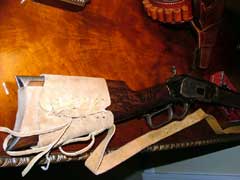
1873
outfitted for hunting - old style sling
|
Since
I am an avid handgun hunter also, I needed a companion handgun
in the same caliber, 38-40. For that I selected the excellent Cimarron
Model P with 7 ˝ inch barrel.
|
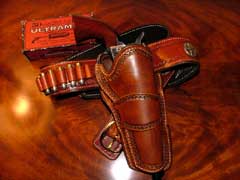
Cimarron Model P .38-40
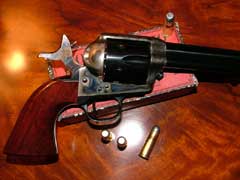
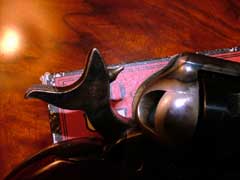
Real hammer on Model P

Cylinder
pin retaining screw can be adjusted to block hammer
|
I
really like the looks and function of the cylinder pin retaining
screw. However, you must watch this when reassembling the
handgun after cleaning. The cylinder pin can be set back far
enough to block the hammer. This is a neat safety feature for
firearms storage but in the field, one can miss a shot a a good
deer if the pin is not returned to the firing position. If that
sounds like experience, well – take the lesson from someone
else.
|
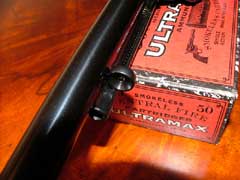
I
love the bulls-eye ejector rod!
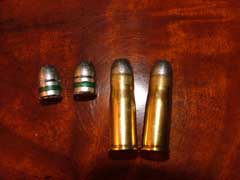
Quick
shot of some of my handloads. More on this in a later
article.
|
Now
I love to load my own ammo, but since I wanted this effort to be
reproducible by any reader who would chose to do so, I selected
factory ammo typical of the loads commonly available in this
cartridge and safe in both the 1873 rifle and revolver. At the
range I tried the Ultramax 180 grain round nose, flat point
cartridge in both the rifle and revolver. In the revolver the
load shot about 1 inch high and true to point of aim at 25
yards. After a minor front sight tightening and adjustment, the
1873 rifle printed in the same place. On the test target both
guns placed six rounds into a single group one inch high and two
inches wide, three shots each. Now that’s a companion
combination. Later when trying the SA out at other ranges I
learned that the SA shot within a two-inch circle out to 50
yards. That’s plenty good for deer hunting at reasonable
ranges for a handgun.
I
have always had a preference for a revolver with a thick front
blade sight. I think it makes it easy to pick up the sight in
poor light and get a precise sight picture for more accurate
aim. This type of sight is found on most of my revolvers
including my favorite USFA 44 Special as shown below:
|

USFA sights |
However,
when I acquired the Cimarron 38-40, it had a rear sight with a
“V” shaped notch and a tapered front blade sight. The sights
are shown below:
|
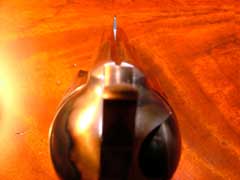
Cimarron .38-40 sights. |
I found that the tapered notch and blade
created a sight combination that was very easy to get a precise
sight alignment in good light. The extra space around the
tapered blade and inverse shape of the front and rear sights
formed a natural contrast. It was easy to get very good shots
off even in the woods.
I
believe the combination will make a fine pair for the CAS
shooter or the hunter who is a little bored with short magnums.
|
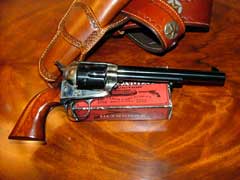
Profile of Model P .38-40 |
Butch
Kent
  
Got something to say about this article? Want to agree (or
disagree) with it? Click the following link to go to the GUNBlast Feedback Page.
|
![]()